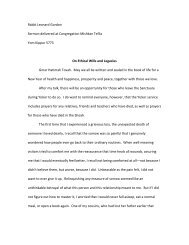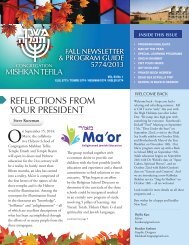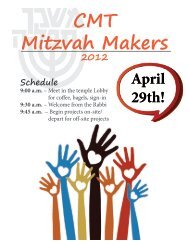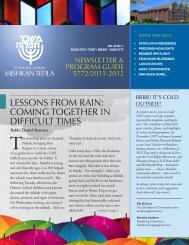-- Pirkei Avot (Sayings of the Sages) - Congregation Mishkan Tefila
-- Pirkei Avot (Sayings of the Sages) - Congregation Mishkan Tefila
-- Pirkei Avot (Sayings of the Sages) - Congregation Mishkan Tefila
- No tags were found...
Create successful ePaper yourself
Turn your PDF publications into a flip-book with our unique Google optimized e-Paper software.
III. Tanakh (Hebrew Bible)IV. Gemilut Chasadim (Social Justice, Mitzvot, Ethics, and Acts <strong>of</strong> Kindness)V. Jewish History and NarrativeVI. IsraelVII. The Jewish Year CycleI. IVRIT (HEBREW)Hebrew is our holy language. Knowledge <strong>of</strong> Hebrew gives us access to our sacred texts andallows us to study <strong>the</strong>m in <strong>the</strong>ir original language. Hebrew is <strong>the</strong> language <strong>of</strong> prayer and <strong>the</strong>prayerbook; it enables Jews to participate in prayer services at any synagogue in <strong>the</strong> world. Itprovides a common bond between Jews, linking Jews throughout <strong>the</strong> world and throughout time. Itconnects us with contemporary Jewish life in Israel. Hebrew language provides us with a tangiblesense <strong>of</strong> community, and <strong>of</strong> belonging to a unique group called into existence by <strong>the</strong> Creator:according to Biblical tradition, it is <strong>the</strong> language with which God created <strong>the</strong> world.Jewish values are <strong>of</strong>ten uniquely embedded and expressed in Hebrew. For example, <strong>the</strong> wordtzedakah, which we sometimes translate as charity, comes from <strong>the</strong> Hebrew root tzadi-dalet-kuf, whichmeans justice, or righteousness. The second part <strong>of</strong> <strong>the</strong> word Beit Knesset, which we translate as“synagogue” comes from <strong>the</strong> root kaf-nun-samech, meaning to ga<strong>the</strong>r, enter, or bring in. The sameroot is found in <strong>the</strong> Hebrew phrase for hospitality (hachnasat orchim). Hebrew words provide us witha Jewish cultural vocabulary that extends well beyond <strong>the</strong>ir literal translation. They provide aparticular lens through which we can come to view our world.The vocabulary <strong>of</strong> Judaism consists <strong>of</strong> words and concepts that have transmitted <strong>the</strong> essence <strong>of</strong>Jewish identity though time- words that are steeped in tradition and history. We teach Hebrewthrough an interdisciplinary approach that includes formal Hebrew instruction, Torah, holidays,mitzvot and tefilah (prayer). Our specific objectives for <strong>the</strong> study <strong>of</strong> <strong>the</strong> Hebrew Language include:Pr<strong>of</strong>iciency in reading, writing and translation <strong>of</strong> Biblical and Modern Hebrew as well assome rabbinic texts, with <strong>the</strong> help <strong>of</strong> supplementary vocabulary and language aids.Pr<strong>of</strong>iciency in tefilah (prayer) and comprehension <strong>of</strong> its content and meaning.Fluency in Hebrew concepts connected to Shabbat and festivals, mitzvot, life cycle events,ethics, values, family and community.Knowledge <strong>of</strong> basic vocabulary and grammatical forms for access to both classical andcontemporary texts and poetry.II.TEFILAH (JEWISH PRAYER)Our objectives for <strong>the</strong> study <strong>of</strong> Jewish prayer and liturgy include:Meaningful exploration <strong>of</strong> prayer as a means to respond to <strong>the</strong> world around us.Fluency with <strong>the</strong> matbea shel <strong>Tefila</strong>, <strong>the</strong> structure <strong>of</strong> <strong>the</strong> Shabbat and daily services, with <strong>the</strong>appropriate melodies.Comprehension <strong>of</strong> <strong>the</strong> meaning and content <strong>of</strong> special prayers for Shabbat and holidays.12









